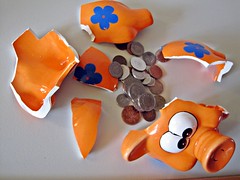
Guest post by Tom Watson, cross-posted at Tom Watson: My Dirty Life and Times
It’s no accident that the ugliest moment in last night’s Republican Presidential debate centered around Texas Congressman Ron Paul and his extremist anti-government views.
“What do you tell a guy who is sick, goes into a coma and doesn’t have health insurance? Who pays for his coverage? “Are you saying society should just let him die?” Wolf Blitzer asked.
“Yeah!” several members of the crowd yelled out.
The question by the CNN anchor - and by the way, how disgraceful was CNN in “partnering” with the fanatical hate-mongering Tea Party Express on the production? - was aimed squarely at Paul’s hard-core conservative libertarianism, a deeply corrosive, amoral force in today’s Republican Party. Paul attempted to soften his response (and the audience’s evident blood lust) by pulling back to the 30,000-foot “Founders” level, the usual 18th century refuge for scoundrels and hypocrites who seek to run the very government apparatus they’d like to abolish. They selectively divine the intentions of Jefferson and Madison (often skipping over Hamilton, the nation’s first great liberal crusader) in a naked attempt to create a laissez faire playground for big business, a kind of giant mainland Cayman Islands.
And every four years in this sad era of never-ending wars, Ron Paul pulls in a few suckers on the civil libertarian left with the shiny penny of vast cuts in defense and military spending (hint: it’s isolationism, folks), while tossing all entitlements and infrastructure and regulation out with the bathwater - along with civil rights, of course.
I agree with Adele Stan on AlterNet: “There are few things as maddening in a maddening political season as the warm and fuzzy feelings some progressives evince for Rep. Ron Paul of Texas, the Republican presidential candidate. The anti-war Republican,’ people say, as if that’s good enough.” She details Rep. Paul’s radical record in the post, but here’s the gist:
But Ron Paul is much, much more than that. He’s the anti-Civil-Rights-Act Republican. He’s an anti-reproductive-rights Republican. He’s a gay-demonizing Republican. He’s an anti-public education Republican and an anti-Social Security Republican. He’s the John Birch Society’s favorite congressman. And he’s a booster of the Constitution Party, which has a Christian Reconstructionist platform. So, if you’re a member of the anti-woman, anti-gay, anti-black, anti-senior-citizen, anti-equality, anti-education, pro-communist-witch-hunt wing of the progressive movement, I can see how he’d be your guy.
This is the man who gave the keynote speech at the 50th anniversary gala of the John Birch Society. Yet many progressives automatically bestow most-favored Republican status on Paul every four years. In one respect, Glenn Greenwald (undoubtedly the preeminent civil liberties blogger on the left) is right: Paul is neither a “fruitcake” nor a “whackjob.” His ideals and ideology are deadly serious, and the product of many years’ labor. He should not be dismissed as “weird” because he doesn’t have Mitt Romney’s hair or Rick Perry’s chest-thumping bluster; both of those guys are essentially professional actors. Ron Paul’s the real deal.
But that real deal is a vision for America that guts the very society created (imperfect and always-challenged, especially in a nation where nearly 50 million people now live in poverty) by our representative democracy. Yet the liberal web is chock-a-block with appreciations for Paul. Dig this from Charles Davis at Counterpunch, who claims Paul “is more progressive” than Barack Obama. (Well yeah, if by “progressive,” you mean “wants to do away with almost all domestic social spending.”) It’s textbook liberal Paul love:
Ron Paul is far from perfect, but I’ll say this much for the Texas congressman: He has never authorized a drone strike in Pakistan. He has never authorized the killing of dozens of women and children in Yemen. He hasn’t protected torturers from prosecution and he hasn’t overseen the torturous treatment of a 23-year-old young man for the “crime” of revealing the government’s criminal behavior.
Can the same be said for Barack Obama?
[snip]
Let’s just assume the worst about Paul: that he’s a corporate libertarian in the Reason magazine/Cato Institute mold that would grant Big Business and the financial industry license to do whatever the hell it wants with little in the way of accountability (I call this scenario the “status quo”). Let’s say he dines on Labradoodle puppies while using their blood to scribble notes in the margins of his dog-eared, gold-encrusted copy of Atlas Shrugged.
So. Fucking. What.
I’ll admit it does have a ring. And yeah, people are angry and rightfully so. But to answer that final question: imagine the demolition of the entire Federal government, back to a level that would barely sustain a loose agrarian federation of competing states. Think of the pain, the anarchy, the tribal and regional disorder. Think of the crowd at the GOP debate lustily cheering death among the uninsured. That’s Ron Paul in charge. So applaud the anti-war talk all you’d like, but pass on the politician and his twisted ideology.
[Photo credit: Gage Skidmore, Creative Commons.]
 Every Friday on Clear it With Sidney, we publish a list of the best socially conscious journalism we’ve seen in the past week. To suggest a story for Sidney’s Picks, tweet @sidneyhillman and use the hashtag #Sidney.
Every Friday on Clear it With Sidney, we publish a list of the best socially conscious journalism we’ve seen in the past week. To suggest a story for Sidney’s Picks, tweet @sidneyhillman and use the hashtag #Sidney.








